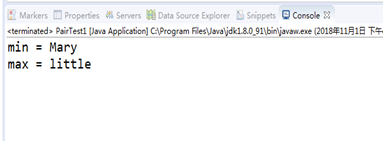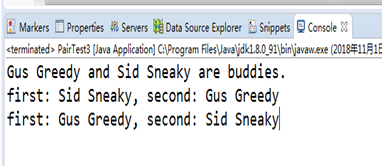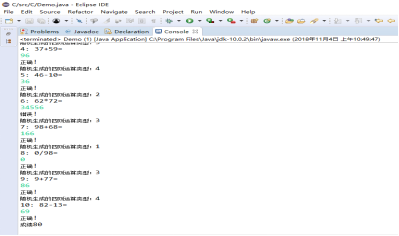201771010135 楊蓉慶《面對物件程式設計(java)》第十週學習總結
1、實驗目的與要求
(1) 理解泛型概念;
(2) 掌握泛型類的定義與使用;
(3) 掌握泛型方法的宣告與使用;
(4) 掌握泛型介面的定義與實現;
(5)瞭解泛型程式設計,理解其用途。
一、理論知識
泛型類的定義:
(1)泛型:也稱引數化型別(parameterized type),就是在定義類、介面和方法時,通過型別引數指示將要處理的物件型。
(2)一個泛型類(generic class)就是具有一個或多個型別變數的類,即建立用型別作為引數的類。
如一個泛型類定義格式如下:class Generics<K,V>
(3)Pair類引入了一個型別變數T,用尖括號(<>)括起來,並放在類名的後面。
泛型變數的限定:
(1)extends關鍵字所宣告的上界既可以是一個類,也可以是一個介面;
(2)<T extends Bounding Type>表示T應該是繫結型別的子型別。
泛型變數下界的說明:
– 通過使用super關鍵字可以固定泛型引數的型別為某種
型別或者其超類
– 當程式希望為一個方法的引數限定型別時,通常可以使
用下限萬用字元
泛型類的約束與侷限性:
不能用基本型別例項化型別引數
執行時型別查詢只適用於原始型別
不能丟擲也不能捕獲泛型類例項
引數化型別的陣列不合法不能例項化型別變數
泛型類的靜態上下文中型別變數無效
注意擦除後的衝突
萬用字元型別:
“?”符號表明引數的型別可以是任何一種型別,它和引數T的含義是有區別的。T表示一種未知型別,而“?”表示任何一種型別.
這種萬用字元一般有以下三種用法:
單獨的?,用於表示任何型別。
? extends type,表示帶有上界。
? super type,表示帶有下界。
二、實驗內容和步驟
實驗1: 匯入第8章示例程式,測試程式並進行程式碼註釋。
測試程式1:
l 編輯、除錯、執行教材311、312頁 程式碼,結合程式執行結果理解程式;
l 在泛型類定義及使用程式碼處添加註釋;
l 掌握泛型類的定義及使用.
package pair1; /** * @version 1.00 2004-05-10 * @author Cay Horstmann */ publicclass Pair<T>//Pair類引入了一個型別變數T { private T first;//use the type variable private T second; public Pair() { first = null; second = null; } public Pair(T first, T second) { this.first = first; this.second = second; }//構造方法的呼叫 public T getFirst() { return first; }//返回值 public T getSecond() { return second; } public void setFirst(T newValue) { first = newValue; }//入口引數 public void setSecond(T newValue) { second = newValue; } }
package pair1; /** * @version 1.01 2012-01-26 * @author Cay Horstmann */ public class PairTest1 { public static void main(String[] args) { String[] words = { "Mary", "had", "a", "little", "lamb" };//定義常量 Pair<String> mm = ArrayAlg.minmax(words);//類名呼叫方法名 System.out.println("min = " + mm.getFirst()); System.out.println("max = " + mm.getSecond());//輸出最大值、最小值 } } class ArrayAlg { /** * Gets the minimum and maximum of an array of strings. * @param a an array of strings * @return a pair with the min and max value, or null if a is null or empty */ public static Pair<String> minmax(String[] a)//泛型類例項化 { if (a == null || a.length == 0) return null; String min = a[0]; String max = a[0]; for (int i = 1; i < a.length; i++) { if (min.compareTo(a[i]) > 0) min = a[i];//compareTo比較方法 if (max.compareTo(a[i]) < 0) max = a[i]; } return new Pair<>(min, max);//例項化後的呼叫物件 } }
結果如下:
測試程式2:
l 編輯、除錯執行教材315頁 PairTest2,結合程式執行結果理解程式;
l 在泛型程式設計程式碼處新增相關注釋;
掌握泛型方法、泛型變數限定的定義及用途。
package pair1; /** * @version 1.00 2004-05-10 * @author Cay Horstmann */ public class Pair<T>//Pair類引入了一個型別變數T { private T first;//use the type variable private T second; public Pair() { first = null; second = null; } public Pair(T first, T second) { this.first = first; this.second = second; }//構造方法的呼叫 public T getFirst() { return first; }//返回值 public T getSecond() { return second; } public void setFirst(T newValue) { first = newValue; }//入口引數 public void setSecond(T newValue) { second = newValue; } }
package pair2; import java.time.*; /** * @version 1.02 2015-06-21 * @author Cay Horstmann */ public class PairTest2 { public static void main(String[] args) { LocalDate[] birthdays = { LocalDate.of(1906, 12, 9), // G. Hopper LocalDate.of(1815, 12, 10), // A. Lovelace LocalDate.of(1903, 12, 3), // J. von Neumann LocalDate.of(1910, 6, 22), // K. Zuse }; Pair<LocalDate> mm = ArrayAlg.minmax(birthdays);//例項化一個LocalDat類 System.out.println("min = " + mm.getFirst()); System.out.println("max = " + mm.getSecond());//得到min、max } } class ArrayAlg { /** Gets the minimum and maximum of an array of objects of type T. @param a an array of objects of type T @return a pair with the min and max value, or null if a is null or empty */ public static <T extends Comparable> Pair<T> minmax(T[] a) //將T限制為實現Comparable介面的類 { if (a == null || a.length == 0) return null; T min = a[0]; T max = a[0]; for (int i = 1; i < a.length; i++)//compareTo方法 { if (min.compareTo(a[i]) > 0) min = a[i]; if (max.compareTo(a[i]) < 0) max = a[i]; } return new Pair<>(min, max);//返回新的pair類 } }
結果如下:
測試程式3:
用除錯執行教材335頁 PairTest3,結合程式執行結果理解程式;
瞭解萬用字元型別的定義及用途。
package pair3; /** * @version 1.01 2012-01-26 * @author Cay Horstmann */ public class PairTest3 { public static void main(String[] args) { //定義Manager類 Manager ceo = new Manager("Gus Greedy", 800000, 2003, 12, 15); Manager cfo = new Manager("Sid Sneaky", 600000, 2003, 12, 15); Pair<Manager> buddies = new Pair<>(ceo, cfo); printBuddies(buddies); ceo.setBonus(1000000); cfo.setBonus(500000); Manager[] managers = { ceo, cfo }; Pair<Employee> result = new Pair<>();//程式呼叫泛型方法 minmaxBonus(managers, result);//泛型方法 System.out.println("first: " + result.getFirst().getName() + ", second: " + result.getSecond().getName()); maxminBonus(managers, result); System.out.println("first: " + result.getFirst().getName() + ", second: " + result.getSecond().getName()); } public static void printBuddies(Pair<? extends Employee> p) { Employee first = p.getFirst(); Employee second = p.getSecond(); System.out.println(first.getName() + " and " + second.getName() + " are buddies."); } public static void minmaxBonus(Manager[] a, Pair<? super Manager> result) //任何泛型Pair型別,它的型別引數是Manager的子類 { if (a.length == 0) return; Manager min = a[0]; Manager max = a[0]; for (int i = 1; i < a.length; i++) { if (min.getBonus() > a[i].getBonus()) min = a[i]; if (max.getBonus() < a[i].getBonus()) max = a[i]; } result.setFirst(min); result.setSecond(max); } public static void maxminBonus(Manager[] a, Pair<? super Manager> result)//統配符限制為Manager的所有超型別 { minmaxBonus(a, result); PairAlg.swapHelper(result); // OK--swapHelper captures wildcard type } // Can't write public static <T super manager> ... } class PairAlg { public static boolean hasNulls(Pair<?> p)//泛型類;型別變數的萬用字元“?” { return p.getFirst() == null || p.getSecond() == null; } public static void swap(Pair<?> p) { swapHelper(p); } //swap呼叫swapHelper public static <T> void swapHelper(Pair<T> p) { T t = p.getFirst(); p.setFirst(p.getSecond()); p.setSecond(t); } }
Employee:
package pair3; import java.time.*; public class Employee //構造一個Employee類 { private String name; private double salary; private LocalDate hireDay; public Employee(String name, double salary, int year, int month, int day) { this.name = name;//this直接引用 this.salary = salary; hireDay = LocalDate.of(year, month, day); } //訪問器方法 public String getName() { return name; } public double getSalary() { return salary; } public LocalDate getHireDay() { return hireDay; } public void raiseSalary(double byPercent) { double raise = salary * byPercent / 100; salary += raise; } }
Manager:
package pair3; public class Manager extends Employee//Manager類的父類是Employee類 { private double bonus; /** @param name the employee's name @param salary the salary @param year the hire year @param month the hire month @param day the hire day */ public Manager(String name, double salary, int year, int month, int day) { super(name, salary, year, month, day); bonus = 0; } public double getSalary() { double baseSalary = super.getSalary(); return baseSalary + bonus; } public void setBonus(double b) { bonus = b; } public double getBonus() { return bonus; } }l
結果如下:

實驗2:程式設計練習:
程式設計練習1:實驗九程式設計題總結
- 實驗九程式設計練習1總結(從程式總體結構說明、模組說明,目前程式設計存在的困難與問題三個方面闡述)。

package ID; import java.io.BufferedReader; import java.io.File; import java.io.FileInputStream; import java.io.FileNotFoundException; import java.io.IOException; import java.io.InputStreamReader; import java.util.ArrayList; import java.util.Arrays; import java.util.Collections; import java.util.Scanner; @SuppressWarnings("unused") public class Main{ private static ArrayList<Person> Personlist; @SuppressWarnings("resource") public static void main(String[] args) { Personlist = new ArrayList<>(); Scanner scanner = new Scanner(System.in); File file = new File("E:\\新建資料夾\\身份證號.txt"); //捕獲程式碼 try { FileInputStream fis = new FileInputStream(file); BufferedReader in = new BufferedReader(new InputStreamReader(fis)); String temp = null; while ((temp = in.readLine()) != null) { Scanner linescanner = new Scanner(temp); linescanner.useDelimiter(" "); String name = linescanner.next(); String ID = linescanner.next(); String sex = linescanner.next(); String age = linescanner.next(); String place =linescanner.nextLine(); Person Person = new Person(); Person.setname(name); Person.setID(ID); Person.setsex(sex); int a = Integer.parseInt(age); Person.setage(a); Person.setbirthplace(place); Personlist.add(Person); } } catch (FileNotFoundException e) { System.out.println("查詢不到資訊"); e.printStackTrace(); } catch (IOException e) { System.out.println("資訊讀取有誤"); e.printStackTrace(); } boolean isTrue = true; while (isTrue) { System.out.println("————————————————————————————————————————"); System.out.println("1:按姓名字典序輸出人員資訊"); System.out.println("2:查詢最大年齡人員資訊和最小年齡人員資訊"); System.out.println("3:輸入你的年齡,查詢年齡與你最近人的所有資訊"); System.out.println("4:查詢人員中是否有你的同鄉"); int nextInt = scanner.nextInt(); switch (nextInt) { case 1: Collections.sort(Personlist); System.out.println(Personlist.toString()); break; case 2: int max=0,min=100;int j,k1 = 0,k2=0; for(int i=1;i<Personlist.size();i++) { j=Personlist.get(i).getage(); if(j>max) { max=j; k1=i; } if(j<min) { min=j; k2=i; } } System.out.println("年齡最大:"+Personlist.get(k1)); System.out.println("年齡最小:"+Personlist.get(k2)); break; case 3: System.out.println("place?"); String find = scanner.next(); String place=find.substring(0,3); String place2=find.substring(0,3); for (int i = 0; i <Personlist.size(); i++) { if(Personlist.get(i).getbirthplace().substring(1,4).equals(place)) System.out.println(""+Personlist.get(i)); } break; case 4: System.out.println("年齡:"); int yourage = scanner.nextInt(); int near=agenear(yourage); int d_value=yourage-Personlist.get(near).getage(); System.out.println(""+Personlist.get(near)); /* for (int i = 0; i < Personlist.size(); i++) { int p=Personlist.get(i).getage()-yourage; if(p<0) p=-p; if(p==d_value) System.out.println(Personlist.get(i)); } */ break; case 5: isTrue = false; System.out.println("退出程式!"); break; default: System.out.println("輸入有誤"); } } } public static int agenear(int age) { int j=0,min=53,d_value=0,k=0; for (int i = 0; i < Personlist.size(); i++) { d_value=Personlist.get(i).getage()-age; if(d_value<0) d_value=-d_value; if (d_value<min) { min=d_value; k=i; } } return k; } }Main
程式總體結構:總體分為Main類和Person類
Main類:
1、將人員身份資訊匯入程式碼中
2、編輯了查詢人員資訊的方法
3、分5個case來分別說年齡大小、同鄉等訊息
Person類:

package ID; public class Person implements Comparable<Person> { private String name; private String ID; private int age; private String sex; private String birthplace; public String getname() { return name; } public void setname(String name) { this.name = name; } public String getID() { return ID; } public void setID(String ID) { this.ID= ID; } public int getage() { return age; } public void setage(int age) { // int a = Integer.parseInt(age); this.age= age; } public String getsex() { return sex; } public void setsex(String sex) { this.sex= sex; } public String getbirthplace() { return birthplace; } public void setbirthplace(String birthplace) { this.birthplace= birthplace; } public int compareTo(Person o) { return this.name.compareTo(o.getname()); } public String toString() { return name+"\t"+sex+"\t"+age+"\t"+ID+"\t"+birthplace+"\n"; } }Person
對各個小模組進行具體的分析
程式設計存在的困難與問題:
1、編寫時基礎錯誤還是很多
2、Main類和Person類的變數名有時不能統一
- 實驗九程式設計練習2總結(從程式總體結構說明、模組說明,目前程式設計存在的困難與問題三個方面闡述)。
程式總體結構:Demo主類和Counter類
模組說明:Demo主類

import java.io.FileNotFoundException; import java.io.PrintWriter; import java.util.Scanner; public class Demo { public static void main(String[] args) { Scanner in = new Scanner(System.in); jf counter=new jf(); PrintWriter out = null; try { out = new PrintWriter("text.txt"); } catch (FileNotFoundException e) { // TODO Auto-generated catch block e.printStackTrace(); } int sum = 0; for (int i = 1; i <=10; i++) { int a = (int) Math.round(Math.random() * 100); int b = (int) Math.round(Math.random() * 100); int m= (int) Math.round(Math.random() * 3); switch(m) { case 0: System.out.println(i+": "+a+"/"+b+"="); while(b==0){ b = (int) Math.round(Math.random() * 100); } int c0 = in.nextInt(); out.println(a+"/"+b+"="+c0); if (c0 == jf.division(a, b)) { sum += 10; System.out.println("恭喜答案正確"); } else { System.out.println("抱歉,答案錯誤"); } break; case 1: System.out.println(i+": "+a+"*"+b+"="); int c = in.nextInt(); out.println(a+"*"+b+"="+c); if (c == counter.multiplication(a, b)) { sum += 10; System.out.println("恭喜答案正確"); } else { System.out.println("抱歉,答案錯誤"); } break; case 2: System.out.println(i+": "+a+"+"+b+"="); int c1 = in.nextInt(); out.println(a+"+"+b+"="+c1); if (c1 == counter.add(a, b)) { sum += 10; System.out.println("恭喜答案正確"); } else { System.out.println("抱歉,答案錯誤"); } break ; case 3: System.out.println(i+": "+a+"-"+b+"="); int c2 = in.nextInt(); out.println(a+"-"+b+"="+c2); if (c2 == counter.reduce(a, b)) { sum += 10; System.out.println("恭喜答案正確"); } else { System.out.println("抱歉,答案錯誤"); } break ; } } System.out.println("成績"+sum); out.println("成績:"+sum); out.close(); } }Demo
1、判斷答案的正確性程式碼
2、檔案的讀取
3、四則運算程式碼的具體呈現
Counter類

public class Counter { private int a; private int b; public int add(int a,int b) { return a+b; } public int reduce(int a,int b) { return a-b; } public int multiplication(int a,int b) { return a*b; } public int division(int a,int b) { if(b!=0) return a/b; else return 0; } }Counter
四則運算的計算過程及返回值
程式設計存在的困難與問題:
1、數值過大,無法口算
2、運算複雜,不符合基礎運算難度
程式設計練習2:採用泛型程式設計技術改進實驗九程式設計練習2,使之可處理實數四則運算,其他要求不變。

package C; import java.io.FileNotFoundException; import java.io.PrintWriter; import java.util.Random; import java.util.Scanner; public class Main { public static void main(String[] args) { Scanner in = new Scanner(System.in); Suanfa counter = new Suanfa(); PrintWriter out = null; try { out = new PrintWriter("test.txt"); } catch (FileNotFoundException e) { System.out.println("資料夾輸出失敗"); e.printStackTrace(); } int sum = 0; for (int i = 1; i <= 10; i++) { int a = (int) Math.round(Math.random() * 100); int b = (int) Math.round(Math.random() * 100); int m; Random rand = new Random(); m = (int) rand.nextInt(4) + 1; System.out.println("隨機生成的四則運算型別:" + m); switch (m) { case 1: a = b + (int) Math.round(Math.random() * 100); while(b == 0){ b = (int) Math.round(Math.random() * 100); } while(a % b != 0){ a = (int) Math.round(Math.random() * 100); } //若生成的除法式子必須能整除,且滿足分母為0的條件,則a一定要大於b,且a模b的結果要為0。 System.out.println(i + ": " + a + "/" + b + "="); int c0 = in.nextInt(); out.println(a + "/" + b + "=" + c0); if (c0 == counter.d(a, b)) { sum += 10; System.out.println("正確!"); } else { System.out.println("錯誤!"); } break; case 2: System.out.println(i + ": " + a + "*" + b + "="); int c = in.nextInt(); out.println(a + "*" + b + "=" + c); if (c == counter.m(a, b)) { sum+= 10; System.out.println("正確!"); } else { System.out.println("錯誤!"); } break; case 3: System.out.println(i + ": " + a + "+" + b + "="); int c1 = in.nextInt(); out.println(a + "+" + b + "=" + c1); if (c1 == counter.add(a, b)) { sum += 10; System.out.println("正確!"); } else { System.out.println("錯誤!"); } break; case 4: while (a < b) { b = (int) Math.round(Math.random() * 100); } //因為不能產生運算結果為負數的減法式子,所以a一定要大於b。若a<b,則重新生成b。 System.out.println(i + ": " + a + "-" + b + "="); int c2 = in.nextInt(); out.println(a + "-" + b + "=" + c2); if (c2 == counter.r(a, b)) { sum += 10; System.out.println("正確!"); } else { System.out.println("錯誤!"); } break; } } System.out.println("成績" + sum); out.println("成績:" + sum); out.close(); } }Main

package C; public class Suanfa<T> { private T a; private T b; public int add(int a,int b) { return a + b; } public int r(int a, int b) { return a - b; } public int m(int a, int b) { return a * b; } public int d(int a, int b) { if (b != 0 && a%b==0) return a / b; else return 0; } }Suanfa
結果如下:


三、總結如下:
本章我們學習了泛型程式設計技術,首先理解了泛型概念,掌握泛型類的定義與使用,泛型方法的宣告與使用,最後感覺瞭解泛型程式設計及其用途,在驗證實驗中,通過對程式碼的解讀,更深的學習了泛型程式<T>的使用,還複習了實驗九的兩個程式設計題目,感覺依舊存在些小問題,在接下來的實驗中要更好的解決,程式設計實驗中,在實驗九的四則運算基礎上,加入了本章泛型程式的概念,雖然不是很熟練,但還是勉強做出來了。

